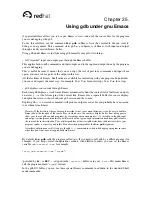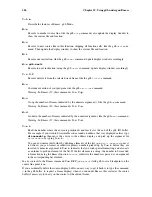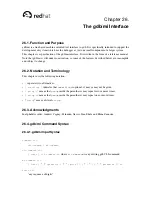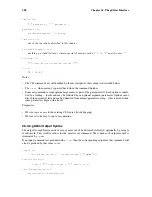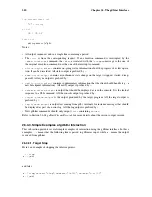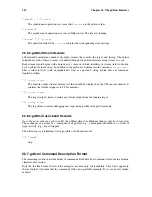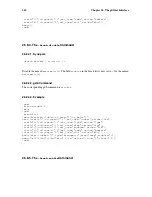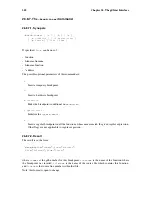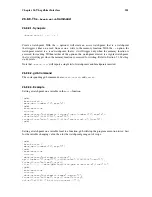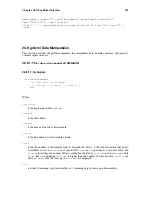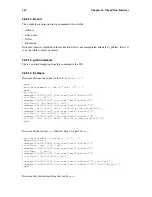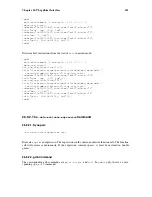
210
Chapter 26. The gdb/mi Interface
log-stream-output
==>
"&"
c-string
nl
==>
CR | CR-LF
token
==>
any sequence of digits
.
Notes:
•
All output sequences end in a single line containing a period.
•
The
token
is from the corresponding request. If an execution command is interrupted by the
-exec-interrupt
command, the
token
associated with the
*stopped
message is the one of
the original execution command, not the one of the interrupt command.
•
status-async-output
contains on-going status information about the progress of a slow opera-
tion. It can be discarded. All status output is prefixed by
+
.
•
exec-async-output
contains asynchronous state change on the target (stopped, started, disap-
peared). All async output is prefixed by
*
.
•
notify-async-output
contains supplementary information that the client should handle (e.g., a
new breakpoint information). All notify output is prefixed by
=
.
•
console-stream-output
is output that should be displayed as is in the console. It is the textual
response to a CLI command. All the console output is prefixed by
~
.
•
target-stream-output
is the output produced by the target program. All the target output is
prefixed by
@
.
•
log-stream-output
is output text coming from gdb’s internals, for instance messages that should
be displayed as part of an error log. All the log output is prefixed by
&
.
•
New gdb/mi commands should only output
lists
containing
values
.
Refer to Section 26.6.2
gdb/mi Stream Records
, for more details about the various output records.
26.4.3. Simple Examples of gdb/mi Interaction
This subsection presents several simple examples of interaction using the gdb/mi interface. In these
examples,
-
S
means that the following line is passed to gdb/mi as input, while
T
-
means the output
received from gdb/mi.
26.4.3.1. Target Stop
Here’s an example of stopping the inferior process:
-
S
-stop
T
- (gdb)
and later:
T
- *stop,reason="stop",address="0x123",source="a.c:123"
T
- (gdb)
Summary of Contents for ENTERPRISE LINUX 3 - SECURITY GUIDE
Page 1: ...Red Hat Enterprise Linux 3 Debugging with gdb ...
Page 12: ...2 Chapter 1 Debugging with gdb ...
Page 28: ...18 Chapter 4 Getting In and Out of gdb ...
Page 34: ...24 Chapter 5 gdb Commands ...
Page 44: ...34 Chapter 6 Running Programs Under gdb ...
Page 68: ...58 Chapter 8 Examining the Stack ...
Page 98: ...88 Chapter 10 Examining Data ...
Page 112: ...102 Chapter 12 Tracepoints ...
Page 118: ...108 Chapter 13 Debugging Programs That Use Overlays ...
Page 138: ...128 Chapter 14 Using gdb with Different Languages ...
Page 144: ...134 Chapter 15 Examining the Symbol Table ...
Page 170: ...160 Chapter 19 Debugging remote programs ...
Page 198: ...188 Chapter 21 Controlling gdb ...
Page 204: ...194 Chapter 22 Canned Sequences of Commands ...
Page 206: ...196 Chapter 23 Command Interpreters ...
Page 216: ...206 Chapter 25 Using gdb under gnu Emacs ...
Page 296: ...286 Chapter 27 gdb Annotations ...
Page 300: ...290 Chapter 28 Reporting Bugs in gdb ...
Page 322: ...312 Chapter 30 Using History Interactively ...
Page 362: ...352 Appendix D gdb Remote Serial Protocol ...
Page 380: ...370 Appendix F GNU GENERAL PUBLIC LICENSE ...
Page 386: ...376 Appendix G GNU Free Documentation License ...
Page 410: ......








